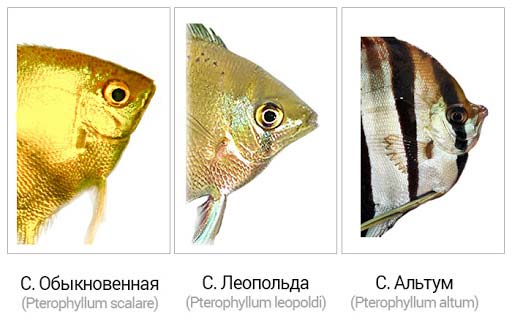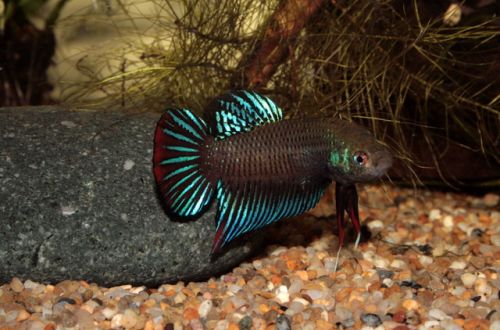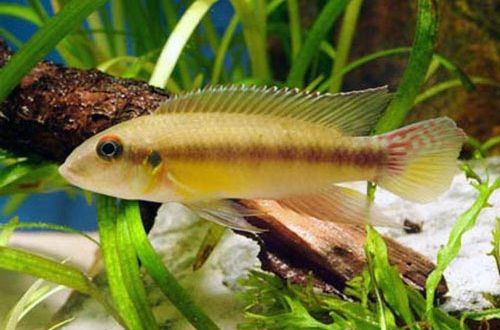
Angelfish High-bodied
High-bodied angelfish or Large angelfish, scientific name Pterophyllum altum, belongs to the Cichlidae family. It is the largest representative of the angelfish (it reaches 18 cm or more in length), but at the same time it has a relatively peaceful disposition, especially at a young age, which allows it to be kept with small fish. Since this species is very demanding on environmental conditions and water quality, it cannot be recommended for beginner aquarists.
In the recent past, only wild representatives of this species, caught from natural reservoirs, were kept in aquariums, this explained the high mortality among fish and, as a result, the impossibility of successful breeding. However, recently the situation has changed, modern equipment and accumulated experience have made it possible not only to adapt the scalar to artificial conditions, but also to produce offspring. Several hybrids have also been bred that are more hardy and unpretentious than their predecessors. It is the last representatives of the High-bodied Skalaria that are widely represented on sale, the original individuals are much less common.
Requirements and conditions:
- The volume of the aquarium – from 200 liters.
- Temperature – 25-29°C
- Value pH — 4.8–6.2
- Water hardness – very soft (1-5dH)
- Substrate type – any
- Lighting – subdued
- Brackish water – no
- Water movement is good
- Size is about 20 cm.
- Meals – any combination with a high protein content
- Life expectancy is 15 years.
Contents
Habitat
It lives in water bodies of South America, mainly in the river basins of the Amazon and Orinoco rivers and their tributaries. They prefer moderately flowing floodplains in very soft and oxygen-rich water. They keep near the coastline with rich vegetation and numerous shelters from the roots and trunks of trees immersed in water. In the wild, they are omnivorous, feeding on small fish and invertebrates, as well as plant debris.
Description
It has a diamond-shaped, strongly flattened laterally high body of about 18 cm and a length of up to 20 cm. In the wild, specimens up to half a meter are often found. Such an impressive size is provided by long dorsal and anal fins. The color is predominantly silvery with a greenish tint. Throughout the body are wide vertical dark brown stripes, continuing on the fins. In some cases, there is a red tinge, especially pronounced in the edging on the tail.
Differences between types of angelfish
 Distinctive features of the three types of angelfish on the example of the shape of the head
Distinctive features of the three types of angelfish on the example of the shape of the head
Food
They belong to omnivorous species, they are happy to accept both dry industrial feeds and live, frozen foods. An important condition for successful keeping is the combination of different types of feed in the daily diet. Feeding 2-3 times a day, everything that is not eaten within five minutes should be removed to avoid overeating and, as a result, fat accumulation and digestive problems.
Maintenance and care
Fish make high demands on the quality of water, it must be very soft and acidic, any changes in the hydrochemical composition adversely affect health. Update weekly, at least 25%, before filling in new water, make sure that it matches the parameters of the water from the aquarium.
An artificial flow should be provided, it can be achieved by installing powerful productive filters, preferably with peat as a filter material, it contributes to an increase in acidity. Equally important is the aeration system, since the angelfish Vysokotelaya is sensitive to the oxygen content in the water. Other mandatory equipment consists of a heater and lighting.
In the design, it is preferable to use numerous shelters around the perimeter of the aquarium in the form of snags, roots, stones, grottoes. In the central part, free space should be left for unhindered swimming. Plants are any that can grow in such conditions, fish are not prone to damage.
Social behavior
Compared to other angelfish, it is a rather peaceful species, gets along with most calm species, however, with age they become territorial and can attack other fish, especially during the spawning period. As neighbors, you can choose either representatives of this species, or any other calm fish, but only for the period of the first 5 years of life, while the angelfish is at a young age and does not have large sizes.
Breeding / Reproduction
Breeding at home in an amateur aquarium is almost impossible. This is due both to the difficulties of determining gender, and the achievement of the necessary external conditions.
Diseases
Fish are susceptible to most common diseases, even a slight change in conditions can provoke a particular ailment. The most common problem is with ichthyophthyroidism, as well as external parasites. Read more about symptoms and treatments in the Aquarium Fish Diseases section.
Features
- Requires high water quality
- Susceptible to various diseases
- Adults become territorial





